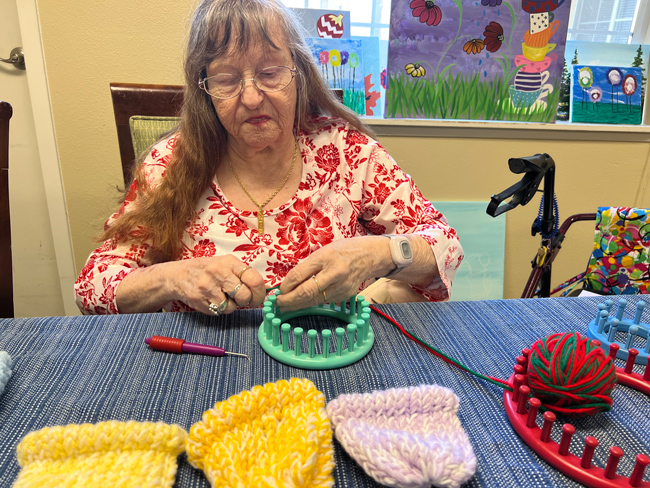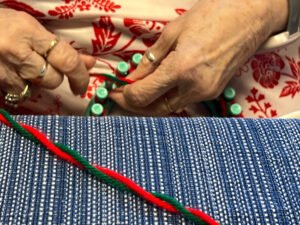
Tiny hats for tiny babies in Richland
Listen
(Runtime 3:44)
Read
Judy Alder, 76, just loves babies. So much so that she spends most of her free time crocheting tiny beanies for their tiny heads. One of her specialities: crafting the smallest of hats for very sick babies in neonatal intensive care units, or NICUs.
“I didn’t get to be a grandma, so I’m making hats for them,” she said. Her son died of a genetic condition called Alpha-1 antitrypsin deficiency.
“I miss him, but he wants me to be happy,” she said.
Making those hats makes her happy, Alder added.
A few years ago, an employee of Brookdale Richland, the senior community where she lives, gave birth to twin preemies. The girls are doing well now. However, at the time, that hospital didn’t have hats for the newborn preemies.
Alder decided she could help fill that gap.
“It was something I could do with these hands. I can’t do a lot of things,” she said, chuckling.
Alder stitches together hats all year long, delivering them each Christmas holiday to Kadlec Regional Medical Center, just down the street from where she lives. For the past three years, she’s made more than 50 hats per year.
“We didn’t even get to go inside the first time. They met us at the door because it was during the bad COVID,” she said.
So far this year, Alder has made at least 67 hats.
As the only Level III NICU in the region, the hospital has 28 beds for sick babies. Parents and babies from all across southeastern and central Washington go there. The unit cares for preemies at the edge of viability to full-term infants who need extra care.

The neonatal intensive care unit, or NICU, at Kadlec Regional Medical Center in Richland. (Courtesy of Kadlec Regional Medical Center)
It turns out, babies born very early need these tiny beanies to help regulate their temperatures, said Anna Wroble, the hospital’s NICU pediatric manager.
“All babies are born with this extra layer of what’s called brown fat, whose number one job is to create heat in a baby and help maintain body warmth,” Wroble said. “Premature babies, when they’re born a little bit early, that brown layer of fat was missed because it’s developed in the last month of pregnancy.”
That’s why it’s a struggle to keep preemies warm, she said. The babies can’t be dressed. Cue heating lamps, incubators and hats.
“Everything is immature: their liver, their stomachs, their brains, everything,” Wroble said. “It allows nurses to be able to see when they’re struggling by the way they’re pulling and breathing. To see the skin color changes because babies can’t say, ‘I don’t feel well, or this hurts.’”
Temperature is one of the main things nurses monitor to gauge an infant’s stability, she said. Cold can stress babies, dropping their blood sugar levels and eventually becoming fatal.
“The beanies aren’t just a fun and compassionate and wonderful thing for our families. It’s also clinically necessary,” Wroble said.
Another clinical necessity: cleanliness. That’s why the NICU needs more hats than it has babies. Nurses wash hats daily to keep infections at bay.
Wroble said preemie parents in the NICU also greatly appreciate Alder’s gesture during a scary and vulnerable time.
“When they come to the NICU and have an itty bitty little baby that you can’t handle frequently, they start to feel a little bit out of control,” she said. “But that gives the family back some control. Make some choices. Choose a cute hat for your baby.”
Helping today’s babies, Alder said making hats sometimes reminds her of her 12-year-old twin great-nieces, who weighed about 4 and 5 pounds, respectively. She didn’t know how to make hats then.
“I wish I knew how to make them,” she said. “When my niece had them, I told her I wanted to be called aunt-grandma. I love them all.”
Like many other grandmas, Alder carries her loom and needle at all times of the day. She’s become an adept, speedy hat maker.

Judy Alder, 76, crochets a hat for a newborn. (Credit: Courtney Flatt / Northwest News Network)
“You wrap, and you take the needle, and you pull it through, and keep on until you get it big enough for a hat,” Alder said, demonstrating her skills. “This is so simple, a child could do it.”
Her yarn preferences are red and purple, likening back to her days as a Red Hat lady in Texas. The women’s social organization gets together and performs services. All of the members are over 50 years old and wear red hats and purple outfits.
Although she loves purple and red, Alder said she’s also made a lot of hats with traditional baby colors. The hospital has requested more blue hats for baby boys after she delivered a lot of pink hats. However, Alder said she’s about to run out of yarn.
Employees at Brookdale Richland said they’d drive Alder to a fabric store for more stretchable yarn, especially because she said she’s not going to stop making hats.
“As long as my hands will let me,” she laughed. “I just think the babies would be so beautiful in them.”















